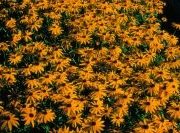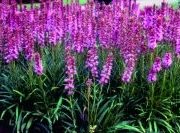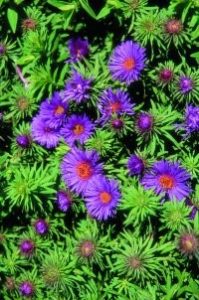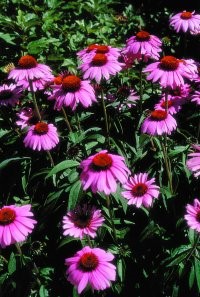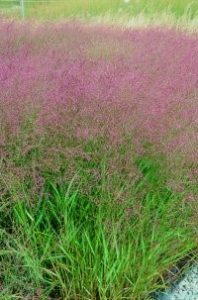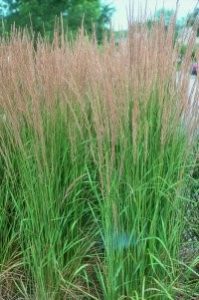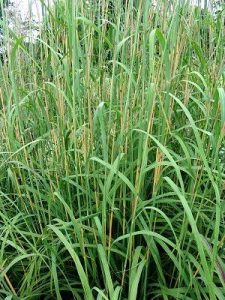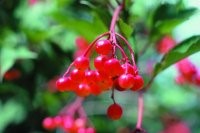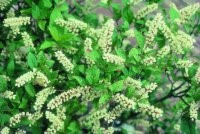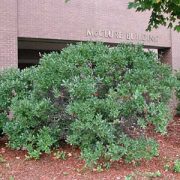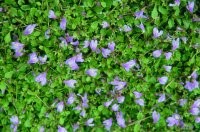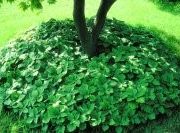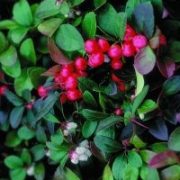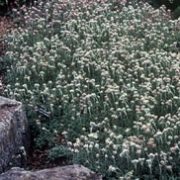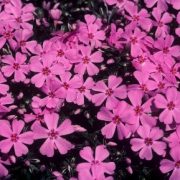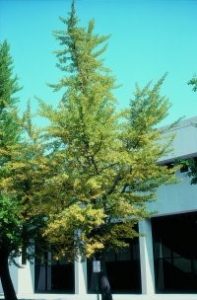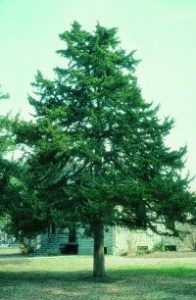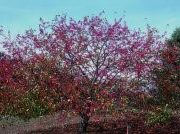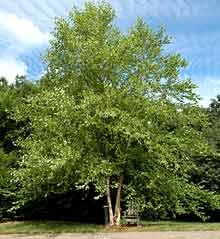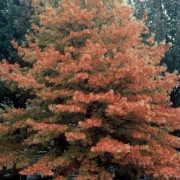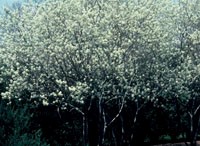LOW MAINTENANCE PLANTS
All plants listed below are drought-tolerant and require little maintenance once established. Plants marked with an asterisk * are native to New England. These plants usually become available at local nurseries during their blooming season. This is just a sampling of some of our favorite plants — ask a trusted landscape professional for additional information. For more beautiful plants, explore the American Beauties native plant collection.
PERENNIALS
Sedum Autumn Joy (Sedum x ‘Autumn Joy’) A well-known favorite that attracts butterflies. Flower heads form in mid-summer and look like broccoli until they turning pink as the summer progresses. Flowers are a deeper rusty-red in the fall.
Moonbeam Coreopsis (Coreopsis verticillata)* Clusters of light yellow, daisy-like blooms with green airy fern-like foliage. Blooms from June through October and is mildew resistant. Stands 24” tall and spreads 18-24” wide. Perennial of the Year in 1992.
Black-eyed Susan (Rudbeckia fulgida ‘Goldsturm’) 2-3’ tall gold-petaled, black-centered, daisy-type flowers bloom continuously from August to October. Seed heads are attractive to birds. Named Perennial Plant of the Year in 1999.
Stella D’oro Daylily (Hemerocallis) One of the finest dwarf daylilies available. Outstanding masses of bright, golden-yellow flowers appear all summer. First flowers appear in May and repeat every few weeks into fall.
Liatris (Liatris species)* A robust and striking perennial also known as Blazing Star and Gayfeather. This attractive plant has an interesting vertical spike of purplish-pink or white flowers. Excellent flower for cutting and drying. Attracts butterflies and hummingbirds.
Purple Dome New England Aster (Aster novae-angliae ‘Purple Dome’)* Compact aster with dark green foliage and profuse bloom of dark purple flowers (up to 1.5” across) which can entirely cover the plant from mid-August until early October. Attractive to butterflies.
Purple Coneflower (Echincea purpurea)* 2-3’ tall, stunning purple-pink flowers (also available in white) with orange centers that resemble large daisies, and are great for cutting. Attracts butterflies; seed heads are good food source for birds. Named Perennial Plant of the Year in 1998.
Blanket Flower (Gaillardia aristata)* These 12” – 16” tall bright yellow daisy-like flowers with burgundy-to-plum colored centers will bring vibrant color to sunny borders and butterfly gardens. Vigorous, easy to grow, and salt tolerant. Begins blooming in late June and continues into fall.
ORNAMENTAL GRASSES
Tall Switchgrass (Panicum virgatum)* This prairie native stands 4-8’ tall and has sturdy erect stems that flower in airy panicles to create a cloud-like effect. Many good cultivars available, including ‘Heavy Metal’, ‘North Wind’, and ‘Shenandoah’.
Little Bluestem (Schizachyrium scoparium)* Clump forming grass growing from 2-4’ tall. Summer color is green to blue green, with pinkish-tan fall color. Best in full sun and poor soils for massing or as a groundcover.
Feather Reed Grass (Calamagrostis x acutiflora ‘Karl Foerster’) A medium sized grass with upright foliage, very carefree and versatile. Buff-colored plumes bloom early (June-July), has sterile seeds. Tolerates clay soils. Perennial Plant of 2001.
Big Bluestem (Andropogon gerardii)* An appealing choice to create a screen or hedge. The 1/2” wide blue-green blades are topped by purplish- bronze pods in the fall. Its pink flower heads are attractive in dried arrangements. With maturity it grows to a graceful 6’. Hardy to zone 3 and prefers low-nutrient soil.
SHRUBS
American Cranberry Viburnum (Viburnum trilobum)* Tall (8’-10’) deciduous shrub with maple shaped leaves and red berries. Sun or medium shade. Good red fall color.
Virginia Sweetspire (Itea virginica)* Deciduous 3-5’ shrub with white flowers in June-July and purplish red fall foliage. Grows in sun or shade. Itea ‘Henry’s Garnet’ is also an excellent selection.
Fothergilla (Fothergilla species)* Spectacular interest throughout the seasons. Small, white, honey-scented flowers on upright spikes in the spring. Summer foliage varies from dark green to blue green; fall leaf color ranges from yellow to orange to red.
Butterfly Bush (Buddleia davidii) Large, fast-growing shrub with arching branches and long panicles of showy summer flowers in pink, purple, white, or orange. Especially attractive to butterflies. 6’. Hardy to zone 3 and prefers low-nutrient soil.
Northern Bayberry (Myrica pensylanica)* Hardy 5’ – 10’ tall shrub with lustrous gray-green leaves. Tolerates full sun to part shade, wind, poor soil and salt spray! Works well massed and combines easily with existing trees. Need at least one male plant for pollination for fruit to set. Grayish-white berries that persist throughout winter attract birds.
GROUNDCOVERS
Creeping Mazus (Mazus repens) Great alternative to grass, however, not suitable for heavy foot-traffic. Low-growing plant has creeping and spreading habit. Semi-evergreen, oval shaped leaves. Attractive, small purple blooms in the late spring.
Allegheny Spurge Pachysandra (Pachysandra procumbens)* An attractive native pachysandra that does well in shade to partial shade. Most winters it is deciduous.
Bearberry (Arctostaphyllis uva ursi)* Creeping native groundcover that grows 6-12” tall, with glossy evergreen foliage that forms broad mats up to 15’ wide. Red berries in July and August. This slow growing shrub provides food for wildlife.
Barren Strawberry (Waldsteinia fragarioides)* An ornamental, strawberry-like plant that may be used in a variety of landscape situations, including slopes. Drought tolerant. Foliage is evergreen, but will turn brown-bronze in cold winters.
Pussy-toes or Pink Everlasting (Antennariarosea)* This is a mat-forming groundcover that once established makes an interesting daisy-like pattern on the ground. The 6” – 8” stems are topped with pink fuzzy flower clusters. Needs well-drained sandy soil. A nice addition to any garden especially in a rockery. Flower head are fantastic in dried arrangements.
Creeping Phlox (Phlox subulata) This semi-evergreen perennial provides abundant color in the late
spring or early summer. The five petal flowers are available in shades of pink, red, lavender, or white. Forms 2’ medium-to-dark green mats at a moderate rate. Prefers a sunny location with well-drained soil. Deadhead when blooming is complete.
TREES
Kousa Dogwood (Cornus kousa) Beautiful white flowers in June; large raspberry-like fruit in late summer. Interesting, exfoliating bark. Resistant to dogwood anthracnose and dogwood borer. Cultivar ‘Rosabella’ has deep rose-pink flowers.
Gingko tree (Gingko biloba)* Large shade tree, 50-80’ at maturity, tolerant of dry conditions and pollution. Spectacular yellow fall foliage. One of oldest trees, growing on earth for 150 million years.
Eastern Red Cedar (Juniperus virgininiana)* Handsome native evergreen with light blue berries that attract wildlife. Excellent as a specimen and useful in masses for windbreaks and screening. Also salt tolerant.
Donald Wyman Crabapple (Malus ‘Donald Wyman’) A disease-resistant crabapple that grows 20-25’ tall. Small red fruit attractive to birds. Interesting bark as it matures.
River Birch (Betula nigra)* Not susceptible to birch borer or miners that plague many birch. This 40’ – 70’ native tree has the characteristic exfoliating bark that is enhanced by a range of hues. Leaves are a lustrous medium to dark green and fall color is a soft yellow.
Pin Oak (Quercus palustris)* Large (50’- 70’) fast growing tree. Strongly pyramidal with central leader and a good shade tree. Fall color is red-to burgundy.
Serviceberry (Amelanchier arborea)* A large shrub or small tree with bark streaked with greyblack markings. Medium to dark green leaves in summer. It is known for its fantastic fall color range: bright yellow, peach, apricot to orange and deep red. Very appropriate in a natural setting with an evergreen backdrop.



